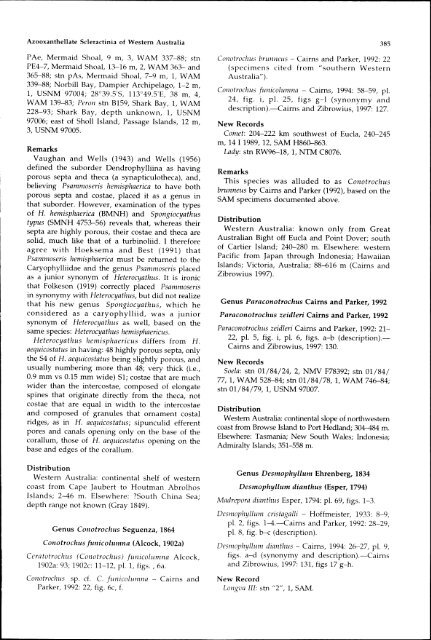Azooxanthellate Scleractinia (Cnidaria: Anthozoa) - Western ...
Azooxanthellate Scleractinia (Cnidaria: Anthozoa) - Western ...
Azooxanthellate Scleractinia (Cnidaria: Anthozoa) - Western ...
Create successful ePaper yourself
Turn your PDF publications into a flip-book with our unique Google optimized e-Paper software.
---------------------------1<br />
<strong>Azooxanthellate</strong> <strong>Scleractinia</strong> of <strong>Western</strong> Australia<br />
PAe, Mermaid Shoal, 9 m, 3, WAM 337-88; stn<br />
PE4-7, Mermaid Shoal, 13-16 m, 2, WAM 363- and<br />
365-88; stn pAs, Mermaid Shoal, 7-9 m, 1, WAM<br />
339-88; Norbill Bay, Dampier Archipelago, 1-2 m,<br />
1, USNM 97004; 28°39.5'S, 113°49.5'E, 38 m, 4,<br />
WAM 139-83; Peron stn B159, Shark Bay, 1, WAM<br />
228-93; Shark Bay, depth unknown, 1, USNM<br />
97006; east of Sholl Island, Passage Islands, 12 m,<br />
3, USNM 97005.<br />
Remarks<br />
Vaughan and Wells (1943) and Wells (1956)<br />
defined the suborder Dendrophylliina as having<br />
porous septa and theca (a synapticulotheca), and,<br />
believing Psammoseris hemisphaerica to have both<br />
porous septa and costae, placed it as a genus in<br />
that suborder. However, examination of the types<br />
of H. hemisphaerica (BMNH) and Spongiocyathus<br />
typus (SMNH 4753-56) reveals that, whereas their<br />
septa are highly porous, their costae and theca are<br />
solid, much like that of a turbinoliid. I therefore<br />
agree with Hoeksema and Best (1991) that<br />
Psammoseris hemisphaerica must be returned to the<br />
Caryophylliidae and the genus Psammoseris placed<br />
as a junior synonym of Heterocyathus. It is ironic<br />
that Folkeson (1919) correctly placed Psammoseris<br />
in synonymy with Heterocyathus, but did not realize<br />
that his new genus Spongiocyathus, which he<br />
considered as a caryophylliid, was a junior<br />
synonym of Heterocyathus as well, based on the<br />
same species: Heterocyathus hemisphaericus.<br />
Heterocyathus hemisphaericus differs from H.<br />
aequicostatus in having: 48 highly porous septa, only<br />
the 54 of H. aequicostatus being slightly porous, and<br />
usually numbering more than 48; very thick (i.e.,<br />
0.9 mm vs 0.15 mm wide) SI; costae that are much<br />
wider than the intercostae, composed of elongate<br />
spines that originate directly from the theca, not<br />
costae that are equal in width to the intercostae<br />
and composed of granules that ornament costal<br />
ridges, as in H. aequicostatus; sipunculid efferent<br />
pores and canals opening only on the base of the<br />
corallum, those of H. aequicostatus opening on the<br />
base and edges of the corallum.<br />
Distribution<br />
<strong>Western</strong> Australia: continental shelf of western<br />
coast from Cape Jaubert to Houtman Abrolhos<br />
Islands; 2-46 m. Elsewhere: ?South China Sea;<br />
depth range not known (Gray 1849).<br />
Genus Conotrochus Seguenza, 1864<br />
Conotrochus funicolumna (Alcock, 1902a)<br />
Ceratotrochus (Conotrochus) funicolzlnll1a Alcock,<br />
1902a: 93; 1902c: 11-12, pI. 1, figs. , 6a.<br />
Conotrochus sp. cf. C. funicolumna - Cairns and<br />
Parker, 1992: 22, fig. 6c, f.<br />
385<br />
Conotrochus brzll1neus Cairns and Parker, 1992: 22<br />
(specimens cited from "southern <strong>Western</strong><br />
Australia").<br />
Conotrochus fwzicolzmma - Cairns, 1994: 58-59, pI.<br />
24, fig. "i, pI. 25, figs g-l (synonymy and<br />
description).-Cairns and Zibrowius, 1997: 127.<br />
New Records<br />
Comet: 204-222 km southwest of Eucla, 240-245<br />
m, 14 I 1989, 12, SAM H860-863.<br />
Lady: stn RW96-18, 1, NTM C8076.<br />
Remarks<br />
This species was alluded to as Conotrochus<br />
brzmneus by Cairns and Parker (1992), based on the<br />
SAM specimens documented above.<br />
Distribution<br />
<strong>Western</strong> Australia: known only from Great<br />
Australian Bight off Eucla and Point Dover; south<br />
of Cartier Island; 240-280 m. Elsewhere: western<br />
Pacific from Japan through Indonesia; Hawaiian<br />
Islands; Victoria, Australia; 88-616 m (Cairns and<br />
Zibrowius 1997).<br />
Genus Paraconotrochus Cairns and Parker, 1992<br />
Paraconotrochus zeidleri Cairns and Parker, 1992<br />
Paraconotrochus zeidleri Cairns and Parker, 1992: 21-<br />
22, pI. 5, fig. i, pI. 6, figs. a-b (description).<br />
Cairns and Zibrowius, 1997: 130.<br />
New Records<br />
Soela: stn 01/84/24, 2, NMV F78392; stn 01/84/<br />
77, 1, WAM 528-84; stn 01/84/78, 1, WAM 746-84;<br />
stn 01/84/79, 1, USNM 97007.<br />
Distribution<br />
<strong>Western</strong> Australia: continental slope of northwestern<br />
coast from Browse Island to Port Hedland; 304-484 m.<br />
Elsewhere: Tasmania; New South Wales; Indonesia;<br />
Admiralty Islands; 351-558 m.<br />
Genus Desmophyllum Ehrenberg, 1834<br />
Desmophyllum dianthus (Esper, 1794)<br />
Madrepora dianthus Esper, 1794: pI. 69, figs. 1-3.<br />
Desnlophyllunl cristagalli - Hoffmeister, 1933: 8-9,<br />
pI. 2, figs. 1-4.-Cairns and Parker, 1992: 28-29,<br />
pI. 8, fig. b--e (description).<br />
Desnlophyllum dianthus - Cairns, 1994: 26-27, pI. 9,<br />
figs. a-d (synonymy and description).-eairns<br />
and Zibrowius, 1997: 131, figs 17 g-h.<br />
New Record<br />
Longva III: Sb1 "2", 1, SAM.
















